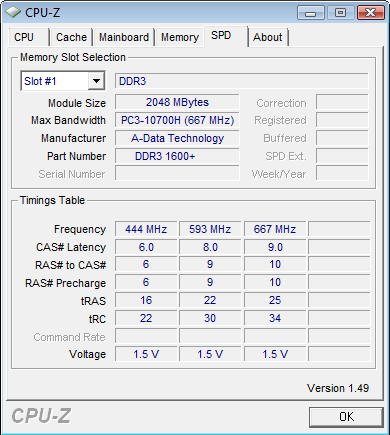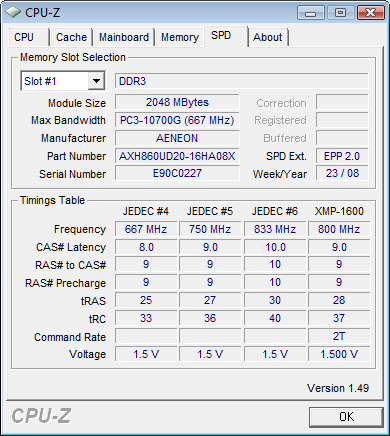Triple-Channel DDR3: 6GB Kit Roundup
A-Data And Aeneon
A-Data Vitesta DDR3-1600+ CAS 8
Sold as part number AD31600E002GMU3K, A-Data’s 6 GB, DDR3-1600 CAS 8 triple-channel kit advertises 8-8-8-24 timings at 1.65 V. A reminder of the product’s past is its maximum 1.85 V overclocking voltage, which is where the plus in the series' name comes from. We certainly won’t be using such high voltage in our Core i7 memory overclocking assessment.
A maximum SPD automatic configuration speed of 667 MHz (DDR3-1333) at 9-10-10-25 timings further indicates that these were developed for the higher-voltage Core 2 platform market, but we were anxious to see how far we could push this product at Core i7-appropriate voltage levels.
A-Data branded products are backed by a full lifetime warranty.
Aeneon XTune DDR3-1600 CAS 9
We mentioned in our introduction that a single company had provided the earlier Core 2 platform market with DDR3-1600 at standard voltage levels, and that company is Aeneon. When it came time for the Core i7 transition, the only update Aeneon had to make was to create a new box for its triple-channel kit.
Because these modules were designed from the outset to operate at standard voltage, SPD automatic configuration speeds up to DDR3-1667 aren’t a problem for Aeneon’s part number AXH860UD20-16H-K-6G, 6 GB triple-channel kit. An XMP extension at DDR3-1600 allows moderate 9-9-9-28 timings to be easily set with no increase in voltage.
Get Tom's Hardware's best news and in-depth reviews, straight to your inbox.
Current page: A-Data And Aeneon
Prev Page Have Memory Manufacturers Dropped The Ball? Next Page Corsair And Crucial-
arkadi Grate article!Reply
What was always bothering me about ram reviews is how much memory speed/timing will really impact on system performance. I it is a lot of work I know, but it was never covered.
-
neiroatopelcc From ArticleOf course, we needed a Core i7 processor, but not just any processor would do. While most reviewers are stuck with engineering samples that only support DDR2-800 and DDR2-1066 ratios (3x and 4x base clock, times two), our retail sample supports data rates all the way up to 2,133 MHz (8x base clock, times two).Reply
I could be wrong, but shouldn't it be ddr3 ? I'm not aware of i7 supporting ddr2? -
Crashman neiroatopelccI could be wrong, but shouldn't it be ddr3 ? I'm not aware of i7 supporting ddr2?Reply
Heheh, looks like it's been edited. -
azone I wounder if amd will do quad channel with its am3 motherboards or even dual 128 bit channels. that would be cool. Just something to beats intels triple 64bit channels.Reply -
Gian124 Anyone know the difference between the followingReply
Kingston HyperX T1 Series Kits:
KHX16000D3T1K3/6GX
KHX16000D3ULT1K3/6GX
What does the UL signify?... would it benchmark the same as the former (which was tested in this article)?
-
'The current problem is one of voltage.'Reply
I loled at that.. maybe it's too early in the morning for me :D -
hexploit Interesting just how few people give a damn about DDR3 at this point.Reply
I guess many are a: Not wowed by i7 like they were core2 and b: Laugh and the prices of DDR3 at a time when DDR2 is not only still very fast relative to the software/games on the market but is dirt cheap. -
Crashman Gian124Anyone know the difference between the following Kingston HyperX T1 Series Kits:KHX16000D3T1K3/6GXKHX16000D3ULT1K3/6GXWhat does the UL signify?... would it benchmark the same as the former (which was tested in this article)?Reply
They may have changed the name.




